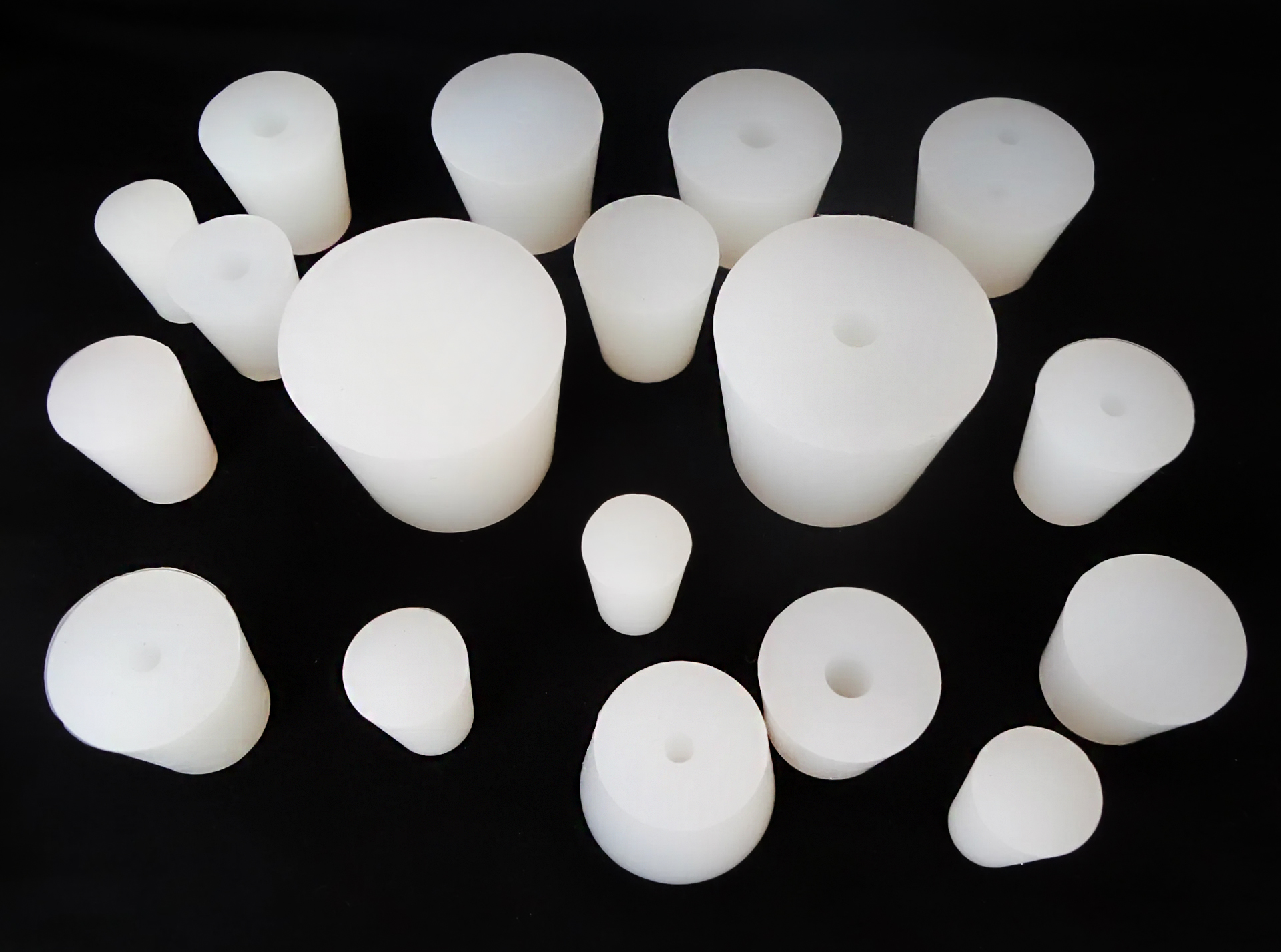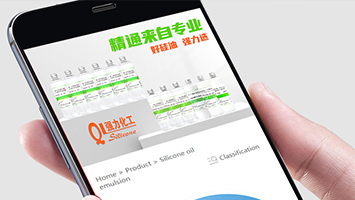Silicone rubber refers to a rubber whose main chain is alternately composed of silicon and oxygen atoms, and the silicon atoms are usually connected with two organic groups. Ordinary silicone rubber is mainly composed of silicone chain links containing methyl groups and a small amount of vinyl groups. The introduction of phenyl groups can improve the high and low temperature resistance of silicone rubber, while the introduction of trifluoropropyl and cyano groups can improve the temperature resistance and oil resistance of silicone rubber. Silicone rubber has good low temperature resistance and can generally still work at -55°C. After the phenyl group is introduced, it can reach -73°C. The heat resistance of silicone rubber is also outstanding. It can work for a long time at 180°C, can withstand temperatures slightly higher than 200°C for several weeks or longer while still being elastic, and can instantly withstand high temperatures above 300°C. Silicone rubber has good air permeability, and its oxygen transmission rate is the highest among synthetic polymers. In addition, silicone rubber has the outstanding properties of being physiologically inert and not causing coagulation, so it is widely used in the medical field.

Depending on the side groups and rubber formulations, silicone rubbers for various uses can be obtained. Several important types of silicone rubber are introduced below.
1. dimethyl silicone rubber
Dimethyl silicone rubber is the earliest silicone rubber put into commercial production. It can maintain good elasticity in the range of -60 to 200°C, has good aging resistance, has excellent electrical insulation properties, moisture resistance, shock resistance, and physiological inertness. characteristic.
Dimethyl silicone rubber is mainly used for fabric coating, and can also be made into various extruded and calendered products for use in electromechanical, aviation, automotive, medical and other industries. However, due to the low vulcanization activity of dimethyl silicone rubber, it is difficult to vulcanize when used to manufacture thick products, the inner layer is prone to blistering, and the high-temperature compression permanent deformation is large, so it has been replaced by methyl vinyl silicone rubber.
2. Methyl vinyl silicone rubber
Since the introduction of a small amount of vinyl into the macromolecular structure of silicone rubber can greatly improve the vulcanization processing performance of silicone rubber, most of the silicone rubber currently used contains vinyl. Methyl vinyl silicone rubber is the most versatile silicone rubber and currently dominates the production of silicone rubber at home and abroad. Because it introduces partially unsaturated vinyl groups on the side chains, its processing performance and physical and mechanical properties are better than those of two-based silicone rubber. In addition to the general characteristics of dimethyl silicone rubber, it also has a wide operating temperature range and can maintain good elasticity in the range of -60 to 260°C. It is easier to vulcanize than dimethyl silicone rubber and has a smaller compression permanent deformation, better resistance to solvent expansion, stability to high-pressure steam, and excellent cold resistance, etc., and because of the use of less active peroxides for processing
It is vulcanized, thereby reducing the weaknesses of bubbles and poor rubber stability during vulcanization. Therefore, methyl vinyl silicone rubber can generally be used to make thicker products.
Methyl vinyl silicone rubber is the most widely used variety of silicone rubber. Various high-performance and special-purpose silicone rubbers that have emerged in recent years are mostly based on vinyl silicone rubber, such as high-strength silicone rubber, low-density silicone rubber, etc. Compression permanent deformation silicone rubber, no post-vulcanization silicone rubber, heat-resistant conductive silicone rubber and medical silicone rubber, etc. In the aviation industry, methyl vinyl silicone rubber is widely used as gaskets, sealing materials and protective layers for fragile and shock-proof components; in the electrical industry, it can be used as advanced insulating materials for electronic components and dynamic sealing rings for high-temperature potentiometers. Seals for underground long-distance communication equipment; in medicine, because methylvinyl silicone rubber has little physiological reaction to the human body and is non-toxic, it is used in plastic surgery, artificial heart valves, blood vessels, etc.
3. Methyl phenyl vinyl silicone rubber
Methyl phenyl vinyl silicone rubber is a product obtained by introducing methyl phenyl silicone chain segments or diphenyl silicone chain segments into the molecular chain of methyl vinyl silicone rubber.
The introduction of phenyl groups into the side groups of polysiloxane destroys the regularity of the dimethylsiloxane structure, greatly reduces the crystallization temperature of the polymer, and expands the low-temperature application range of the polymer material. Therefore, in addition to the small compression permanent deformation, wide operating temperature range, antioxidant, weather resistance, shockproof, moisture-proof and good electrical insulation properties of methylphenyl vinyl silicone rubber, methylphenyl vinyl silicone rubber also has excellent Low temperature resistance, ablation resistance and radiation resistance. These properties vary with the phenyl content in the molecular chain. Generally speaking, the phenyl content (ratio of phenyl to silicon atoms) is between 5 and 10%. It is sometimes called low phenyl silicone rubber. It has unique cold-resistant properties and can still maintain the elasticity of rubber at -70~-100℃. It is the best low-temperature performance among all rubbers. In addition, it also contains methyl vinyl silicone. Due to the advantages of rubber and its low cost, there is a strong trend to replace methyl vinyl silicone rubber. When the phenyl content is 20 to 40%, it is called medium phenyl silicone rubber. It has excellent flame resistance and can self-extinguish once it catches fire. When the phenyl content is 40 to 50%, it is called high phenyl silicone rubber. It has excellent radiation resistance, and its gamma-ray resistance is 1xI08 roentgen. Generally speaking, as the phenyl content increases, the rigidity of the silicone rubber molecular chain gradually increases, and the low-temperature resistance of silicone rubber gradually decreases. However, as the phenyl content increases, the flame resistance and radiation resistance of the vulcanized rubber are improved. Illumination.
Methyl phenyl vinyl silicone rubber is one of the important materials in the aerospace industry, cutting-edge technology and other sectors of the national economy. It can be used to make various molded and extruded products and is used as cold-resistant rubber in the aviation industry and for ablation resistance, Seals, gaskets, pipes and rods for heat-aging or radiation-resistant parts.
4. Fluorosilicone rubber
Fluorosilicone rubber refers to γ-trifluoropropylmethylpolysiloxane. Fluorosilicone rubber has excellent resistance to chemicals, solvents and lubricants. This kind of silicone rubber has a small expansion rate in non-polar solvents, good cold resistance and thermal stability, and good fire resistance, so it is used in aircraft. , rockets, missiles, space flight, petrochemical industry, used as hoses, gaskets, sealing rings, fuel tanks, etc. in contact with fuel oil and lubricating oil. It can also be used to make corrosion-resistant clothes, gloves, coatings, adhesives, etc. .
5. Nitrile silicone rubber
Since the side chain of the polymer molecule contains β-nitrile ethyl or γ-nitrile propyl strong polar groups, the inter-molecular force is greatly increased and the oil and solvent resistance are improved. At the same time, due to the introduction of a certain amount of nitrile alkyl groups, the regularity of the polymer structure is destroyed and the cold resistance is greatly improved. The type and content of nitrile alkyl groups have a great impact on performance. For example, silicone rubber containing 7.5 mol% of γ-nitrile propyl group has low-temperature properties similar to low phenyl silicone rubber (its glass transition temperature is -114.5°C). Oil resistance is better than phenyl silicone rubber. As the γ-nitrile propyl content increases to 33 to 50 mol%, the cold resistance decreases and the oil resistance improves. Replacing γ-nitrile propyl group with β-nitrile ethyl group can improve the heat resistance of nitrile silicone rubber and can withstand hot air aging at 250°C.
The main advantage of nitrile silicone rubber is that it has excellent oil resistance and bath agent resistance, and can maintain elasticity in the range of -60 to 180°C. Therefore, it can be made into oil-resistant rubber products for use in the aviation industry, automobile industry and petroleum industry; also It can be used as an environmental sealant and fuel tank sealant for high-performance aircraft, and can maintain sealing at temperatures from -54°C to over 200°C. Nitrile silicone rubber can be processed with ordinary equipment.
6.Phylene silicone rubber
The main feature of phenylene silicone rubber is its excellent radiation resistance. Its radiation resistance is 10 to 15 times that of general methyl vinyl silicone rubber and 5 to 10 times that of high phenyl silicone rubber. Therefore, it can be used It is used in the aerospace industry, atomic energy industry and nuclear reactors as cables, sheaths, gaskets and heat shrinkable tubes that are resistant to high-energy radiation.
7.Ethyl silicone rubber
Diethyl silicone rubber, which is made by introducing ethyl groups into polysiloxane side chains, has particularly good cold resistance, and its cold resistance is better than dimethyl silicone rubber and general methylvinyl silicone rubber. The higher the ethyl content, the better the cold resistance. However, the reactivity of ethyl group is greater than that of methyl group. Therefore, as the ethyl group content increases, the heat resistance decreases. As an ethyl silicone rubber for low-temperature use, it is appropriate to contain 8 mol% of diethyl silicone chain segments in the polymer. The service temperature of ethyl silicone rubber is generally -70~200℃.
8. Silicone rubber
The main advantage of silicone rubber is its excellent thermal stability. It does not decompose at 430~480℃, and some can even withstand high temperatures above 500℃. The outstanding weakness of silicone rubber is its poor hydrolytic stability, and it was once considered to have no future. Later, it was discovered that polymers with cyclodisilazane introduced into the main chain have good thermal stability. The cyclodisilazane-containing elastomer modified with silarylene does not lose weight when heated to 425°C in air, and loses only 10% at 570°C, and has good hydrolysis stability.




